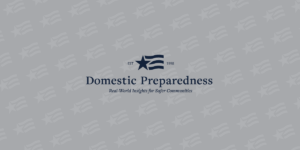

Understanding Public Health Emergency Declarations
Raphael M. Barishansky
January 23, 2013
Although avian influenza outbreaks occur periodically in poultry flocks, only recently has avian influenza been considered a significant threat to human health and the global economy. The 1997 emergence of H5N1 first brought attention to avian influenza’s ability to cause disease in humans. However, human infection with influenza from avian sources is not a new phenomenon.

Preparing a Region for the Nation’s Inauguration
Craig DeAtley
January 23, 2013
Unlike the sudden release of toxic chemical agents, pathogens often are difficult to detect and prevent. Such threats evolve over time and have the ability to silently spread between communities. Identifying the threat early would help slow or prevent the spread of disease before it overwhelms a community’s response capabilities.

National Special Security Events: Transportation Checklists
Laurel J. Radow
January 23, 2013
Transportation to and from any special event can be a challenge, but there are additional requirements that must be met for events of national significance with the highest level of security. In the United States, the Federal Highway Administration provides checklists, publications, and even peer-to-peer support for professionals tasked with planning such events.

2013 Great Central U.S. ShakeOut
Domestic Preparedness
January 22, 2013
You are invited to join more than one million people who will drop, cover, and hold during the
Great Central U.S. ShakeOut on 7 February 2013. This regional earthquake drill will include participants
across nine states – and they will practice what to do when an actual earthquake occurs.

A Continuing Need for Accurate All-Hazard Assessments
Joseph W. Trindal
January 20, 2013
Making plans to avoid a perceived hazard can sometimes create a real hazard when a careful risk
assessment is not conducted. Local hazmat and law enforcement experts must be brought in to work with
public and private agencies before decisions about sheltering and establishing evacuation routes for
those in danger are determined.

Active Shooter Preparedness
Domestic Preparedness
January 18, 2013
The Department of Homeland Security (DHS) aims to enhance preparedness through a “whole community”
approach by providing training, products, and resources to a broad range of stakeholders on issues such
as active shooter awareness, incident response, and workplace violence.

An Overlooked Factor in Mass Killings
Joseph W. Trindal
January 16, 2013
Violent crime may be decreasing in the United States, but mass killings seem to be on the rise.
Although media play a critical role in raising situational awareness, there are associated costs –
misinformation, emotionally driven dialogue, and information that not only assists planning for other
would-be attackers, but may possibly have a “contagion” effect.

Air, Sea, Land: No Detail Left Unplanned
Scott L. Brillman
January 16, 2013
As tall ships sailed into port, the U.S. Navy’s Blue Angels flew overhead, and visitors filled the streets, the 2012 Sailabration in Baltimore, Maryland, became not only an official celebration but also a unique special event that required the collaboration, cooperation, and combined talents of hundreds of local volunteers and scores of senior officials.

Building a Bigger Better Buffer Zone Protection Plan
Richard Morman
January 16, 2013
Criticality, accessibility, recuperability, vulnerability, effect, and recognizability – all are essential elements that help identify risks and determine a course of action to protect potential targets of terrorist activity. By identifying risks and creating a “buffer zone” to protect valuable infrastructure, special events such as football games at The Ohio State University can continue to be as safe as possible.

Special Events Challenges – A Sesquicentennial Example
Stephen Grainer
January 9, 2013
Much has changed in 150 years, but there are some constants – weather, geography, population – that are almost always changing. By understanding local climate conditions, the topography and transportation challenges involved, and the sometimes malicious intent of certain attendees, special event planners can prevent or at least mitigate the effect of dangerous incidents and emergencies.

